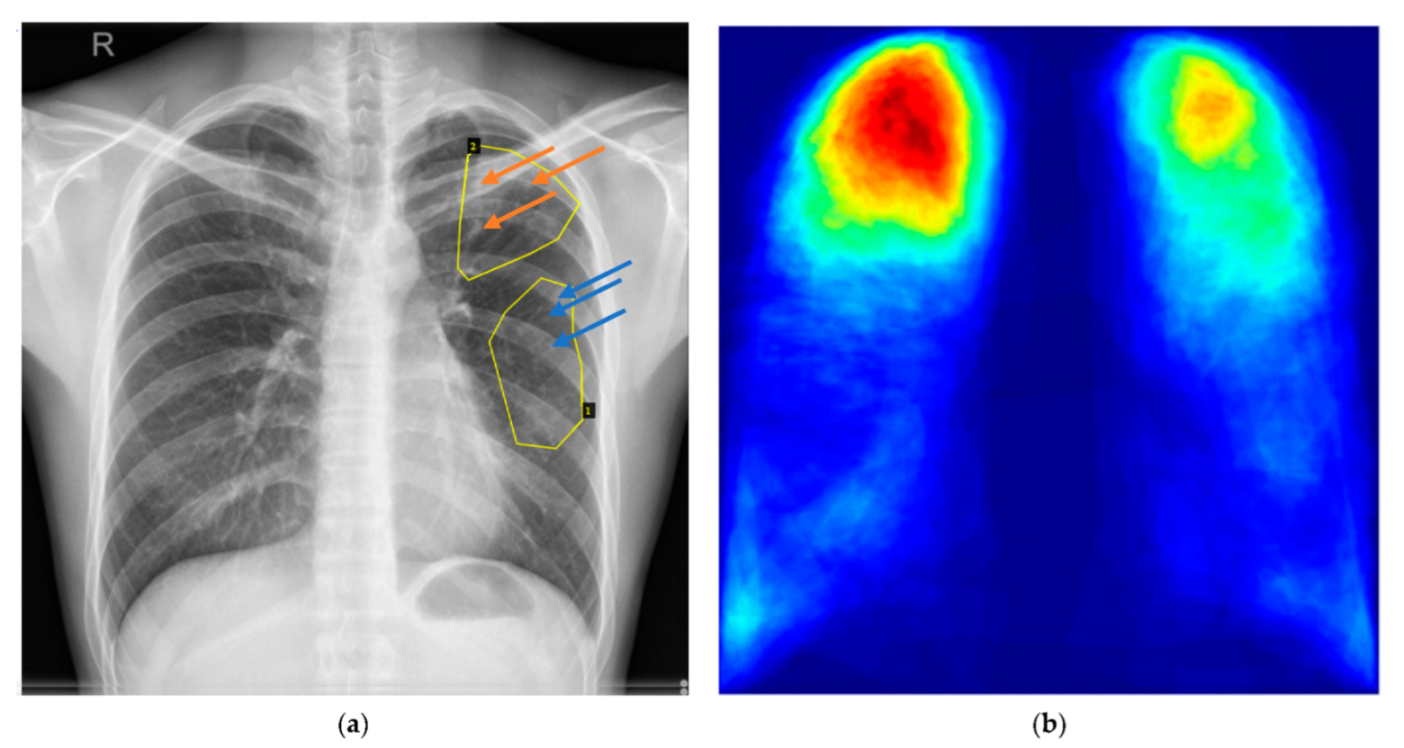Annotations of Lung Abnormalities in the Shenzhen Chest X-ray Dataset for Computer-Aided Screening of Pulmonary Diseases
Abstract
:1. Introduction
2. Annotations of Lung Abnormalities for TB Patients in Shenzhen CXR Dataset
2.1. Annotations in JSON Format and Visualization
2.2. Binary Abnormality Masks
- CHNCXR_0329_1_Clustered_Nodule_(2mm-5mm_apart)_1.png
- CHNCXR_0329_1_Calcified_Nodule_2.png.
2.3. CSV File
3. Summary
Author Contributions
Funding
Institutional Review Board Statement
Informed Consent Statement
Data Availability Statement
Acknowledgments
Conflicts of Interest
Notes
| 1 | |
| 2 |
References
- World Health Organization (WHO). Global Tuberculosis Report; World Health Organization: Geneva, Switzerland, 2021.
- Pande, T.; Pai, M.; Khan, F.A.; Denkinger, C.M. Use of Chest Radiography in the 22 Highest Tuberculosis Burden Countries. Eur. Respir. J. 2015, 46, 1816–1819. [Google Scholar] [CrossRef] [PubMed] [Green Version]
- World Health Organization. Chest Radiography in Tuberculosis Detection-Summary of Current WHO Recommendations and Guidance on Programmatic Approaches. WHO Libr. Cat. Data 2016. Available online: https://apps.who.int/iris/handle/10665/252424 (accessed on 7 July 2022).
- Jaeger, S.; Karargyris, A.; Candemir, S.; Siegelman, J.; Folio, L.; Antani, S.; Thoma, G. Automatic Screening for Tuberculosis in Chest Radiographs: A Survey. Quant. Imaging Med. Surg. 2013, 3, 89–99. [Google Scholar] [CrossRef]
- Jaeger, S.; Candemir, S.; Antani, S.; Wáng, Y.-X.J.; Lu, P.-X.; Thoma, G. Two Public Chest X-Ray Datasets for Computer-Aided Screening of Pulmonary Diseases. Quant. Imaging Med. Surg. 2014, 4, 475–477. [Google Scholar] [CrossRef]
- Liu, Y.; Wu, Y.H.; Ban, Y.; Wang, H.; Cheng, M.M. Rethinking Computer-Aided Tuberculosis Diagnosis. In Proceedings of the IEEE Computer Society Conference on Computer Vision and Pattern Recognition, Seattle, WA, USA, 16–18 June 2020. [Google Scholar]
- Beard, D. Firefly-Web-Based Interactive Tool for the Visualization and Validation of Image Processing Algorithms. Ph.D. Thesis, University of Missouri, Columbia, MO, USA, 2009. [Google Scholar]
- Staziaki, P.V.; Santinha, J.A.A.; Coelho, M.O.; Angulo, D.; Hussain, M.; Folio, L.R. Gamification in Radiology Training Module Developed During the Society for Imaging Informatics in Medicine Annual Meeting Hackathon. J. Digit. Imaging 2022, 35, 714–722. [Google Scholar] [CrossRef] [PubMed]
- Dutta, A.; Zisserman, A. The VIA Annotation Software for Images, Audio and Video. In Proceedings of the MM 2019—27th ACM International Conference on Multimedia, Nice, France, 21–25 October 2019. [Google Scholar]

| Abnormality Type | Total Number | Abnormality Type | Total Number |
|---|---|---|---|
| Pleural effusion | 59 | Clustered nodule (2 mm–5 mm apart) | 146 |
| Apical thickening | 57 | Linear density | 138 |
| Single nodule (non-calcified) | 130 | Adenopathy | 21 |
| Pleural thickening (non-apical) | 49 | Calcification (other than nodule and lymph node) | 19 |
| Calcified nodule | 79 | Calcified lymph node | 2 |
| Small infiltrate (non-linear) | 163 | Miliary TB | 6 |
| Moderate infiltrate (non-linear) | 147 | Retraction | 10 |
| Severe infiltrate (consolidation) | 35 | Other | 18 |
| Cavity | 45 | Unknown | 14 |
| Thickening of the interlobar fissure | 15 |
Publisher’s Note: MDPI stays neutral with regard to jurisdictional claims in published maps and institutional affiliations. |
© 2022 by the authors. Licensee MDPI, Basel, Switzerland. This article is an open access article distributed under the terms and conditions of the Creative Commons Attribution (CC BY) license (https://creativecommons.org/licenses/by/4.0/).
Share and Cite
Yang, F.; Lu, P.X.; Deng, M.; Wáng, Y.X.J.; Rajaraman, S.; Xue, Z.; Folio, L.R.; Antani, S.K.; Jaeger, S. Annotations of Lung Abnormalities in the Shenzhen Chest X-ray Dataset for Computer-Aided Screening of Pulmonary Diseases. Data 2022, 7, 95. https://doi.org/10.3390/data7070095
Yang F, Lu PX, Deng M, Wáng YXJ, Rajaraman S, Xue Z, Folio LR, Antani SK, Jaeger S. Annotations of Lung Abnormalities in the Shenzhen Chest X-ray Dataset for Computer-Aided Screening of Pulmonary Diseases. Data. 2022; 7(7):95. https://doi.org/10.3390/data7070095
Chicago/Turabian StyleYang, Feng, Pu Xuan Lu, Min Deng, Yì Xiáng J. Wáng, Sivaramakrishnan Rajaraman, Zhiyun Xue, Les R. Folio, Sameer K. Antani, and Stefan Jaeger. 2022. "Annotations of Lung Abnormalities in the Shenzhen Chest X-ray Dataset for Computer-Aided Screening of Pulmonary Diseases" Data 7, no. 7: 95. https://doi.org/10.3390/data7070095
APA StyleYang, F., Lu, P. X., Deng, M., Wáng, Y. X. J., Rajaraman, S., Xue, Z., Folio, L. R., Antani, S. K., & Jaeger, S. (2022). Annotations of Lung Abnormalities in the Shenzhen Chest X-ray Dataset for Computer-Aided Screening of Pulmonary Diseases. Data, 7(7), 95. https://doi.org/10.3390/data7070095










